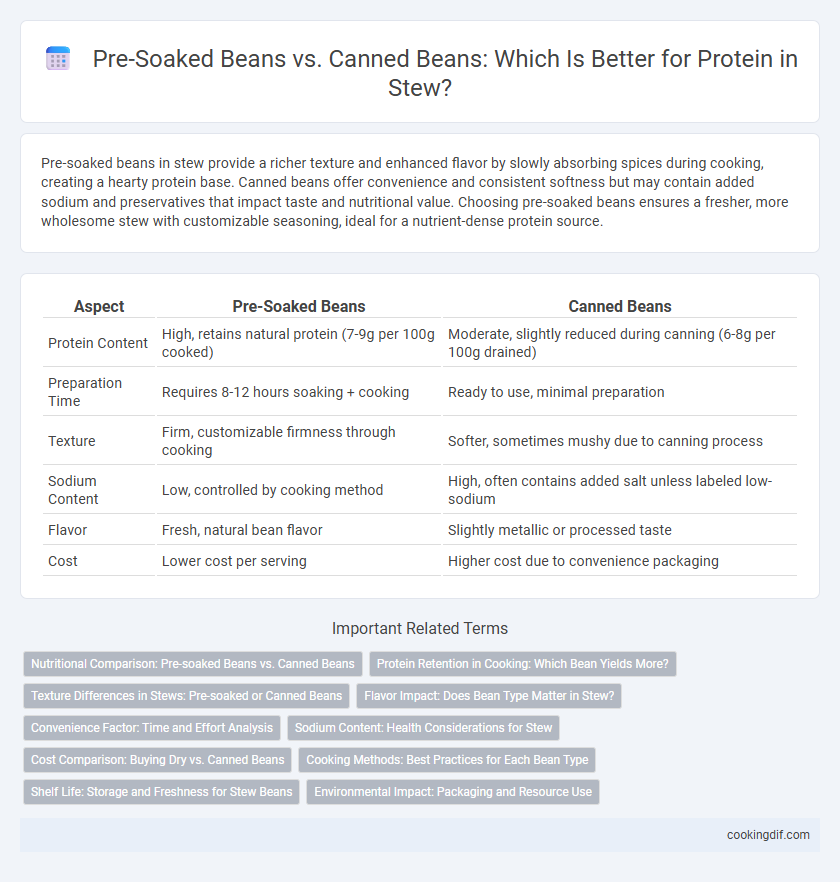Pre-soaked beans in stew provide a richer texture and enhanced flavor by slowly absorbing spices during cooking, creating a hearty protein base. Canned beans offer convenience and consistent softness but may contain added sodium and preservatives that impact taste and nutritional value. Choosing pre-soaked beans ensures a fresher, more wholesome stew with customizable seasoning, ideal for a nutrient-dense protein source.
Table of Comparison
| Aspect | Pre-Soaked Beans | Canned Beans |
|---|---|---|
| Protein Content | High, retains natural protein (7-9g per 100g cooked) | Moderate, slightly reduced during canning (6-8g per 100g drained) |
| Preparation Time | Requires 8-12 hours soaking + cooking | Ready to use, minimal preparation |
| Texture | Firm, customizable firmness through cooking | Softer, sometimes mushy due to canning process |
| Sodium Content | Low, controlled by cooking method | High, often contains added salt unless labeled low-sodium |
| Flavor | Fresh, natural bean flavor | Slightly metallic or processed taste |
| Cost | Lower cost per serving | Higher cost due to convenience packaging |
Nutritional Comparison: Pre-soaked Beans vs. Canned Beans
Pre-soaked beans retain a higher nutrient profile compared to canned beans, offering increased levels of fiber, protein, and essential vitamins due to minimal processing. Canned beans often contain added sodium and preservatives, which can reduce their overall nutritional value and impact heart health. Choosing pre-soaked beans for stew ensures a richer protein content and better nutrient absorption, enhancing the stew's dietary benefits.
Protein Retention in Cooking: Which Bean Yields More?
Pre-soaked beans retain more protein in stew due to controlled cooking times that prevent nutrient loss, while canned beans often lose some protein during industrial processing and high-heat sterilization. Studies show pre-soaked beans maintain up to 90% of their original protein content after cooking, compared to around 75% in canned varieties. Choosing pre-soaked beans enhances protein retention and boosts the nutritional value of stew recipes.
Texture Differences in Stews: Pre-soaked or Canned Beans
Pre-soaked beans provide a firmer, creamier texture in stews, as soaking softens the beans evenly and reduces cooking time, preserving their shape and bite. Canned beans, while convenient, tend to be softer and may break down more quickly during cooking, resulting in a mushier texture. Chefs often prefer pre-soaked beans for stews to achieve a more controlled, hearty consistency that enhances the overall mouthfeel and protein quality.
Flavor Impact: Does Bean Type Matter in Stew?
Pre-soaked beans impart a richer, more robust flavor to stew compared to canned beans, which often have a milder taste due to the canning process and preservatives. The texture of pre-soaked beans tends to be firmer and creamier, enhancing the overall mouthfeel and protein quality in the stew. Although canned beans offer convenience, using pre-soaked beans allows for better absorption of spices and broth, significantly elevating the stew's flavor depth.
Convenience Factor: Time and Effort Analysis
Pre-soaked beans require several hours of soaking plus extended cooking time, making them less convenient for quick stew preparation compared to canned beans, which are pre-cooked and ready to use immediately. Canned beans significantly reduce meal prep time and effort without sacrificing protein content, ideal for busy schedules or last-minute cooking. While pre-soaked beans offer customizable texture and flavor, canned beans provide unmatched convenience for efficient stew protein sourcing.
Sodium Content: Health Considerations for Stew
Pre-soaked beans drastically reduce sodium content compared to canned beans, which often contain high levels of added salt. Choosing pre-soaked beans for stew helps control sodium intake, supporting heart health and reducing hypertension risks. Lowering sodium by using pre-soaked beans enhances the nutritional quality and healthfulness of protein-rich stews.
Cost Comparison: Buying Dry vs. Canned Beans
Pre-soaked dry beans offer a significantly lower cost per serving compared to canned beans, making them a budget-friendly protein option for stew. Dry beans typically cost $1 to $2 per pound and expand up to three times when cooked, while canned beans can cost $1 to $1.50 per can with less volume. Choosing dry beans reduces long-term expenses and provides greater control over sodium and additives in your stew.
Cooking Methods: Best Practices for Each Bean Type
Pre-soaked beans require longer cooking times and gradual simmering to ensure even texture and full protein extraction, while canned beans benefit from shorter heating to avoid becoming mushy and to retain firmness in stew. When using pre-soaked beans, starting with cold water and bringing to a gentle boil helps maintain nutrient density and reduces cooking time compared to dry beans. For canned beans, rinsing before adding to stew decreases sodium content and prevents excess starch, optimizing flavor and texture in protein-rich dishes.
Shelf Life: Storage and Freshness for Stew Beans
Pre-soaked beans for stew offer a customizable texture and flavor but require refrigeration and typically last up to five days once soaked. Canned beans provide convenience with a longer shelf life, often lasting one to two years unopened, due to vacuum sealing and preservatives. Choosing between pre-soaked and canned beans affects stew freshness, where pre-soaked beans yield a fresher taste but demand timely usage, while canned beans ensure extended storage and immediate availability.
Environmental Impact: Packaging and Resource Use
Pre-soaked beans significantly reduce environmental impact by cutting down cooking energy and water compared to canned beans, which require intensive processing and sterilization. Canned beans involve aluminum or steel cans that contribute to packaging waste, while pre-soaked beans minimize single-use packaging when bought in bulk or loose form. Choosing pre-soaked beans supports lower resource consumption and waste generation, making them a more sustainable protein option for stew.
Pre-soaked beans vs canned beans for stew protein Infographic

 cookingdif.com
cookingdif.com